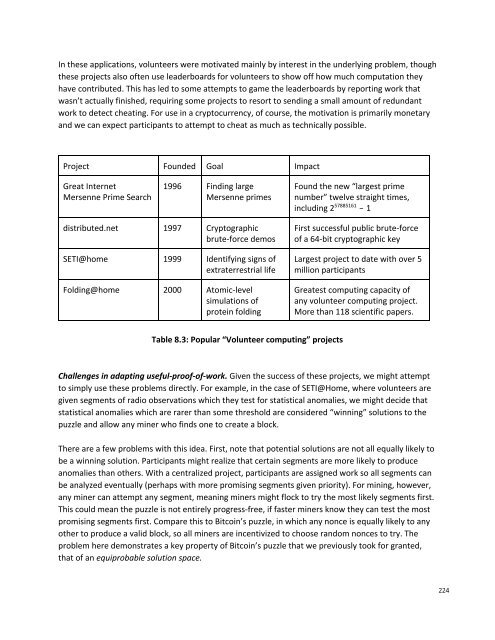Bitcoin and Cryptocurrency Technologies
1Qqc4BN
1Qqc4BN
Create successful ePaper yourself
Turn your PDF publications into a flip-book with our unique Google optimized e-Paper software.
In these applications, volunteers were motivated mainly by interest in the underlying problem, though<br />
these projects also often use leaderboards for volunteers to show off how much computation they<br />
have contributed. This has led to some attempts to game the leaderboards by reporting work that<br />
wasn’t actually finished, requiring some projects to resort to sending a small amount of redundant<br />
work to detect cheating. For use in a cryptocurrency, of course, the motivation is primarily monetary<br />
<strong>and</strong> we can expect participants to attempt to cheat as much as technically possible.<br />
Project Founded Goal Impact<br />
Great Internet<br />
Mersenne Prime Search<br />
1996 Finding large<br />
Mersenne primes<br />
Found the new “largest prime<br />
number” twelve straight times,<br />
including 2 57885161 − 1<br />
distributed.net 1997 Cryptographic<br />
brute‐force demos<br />
SETI@home 1999 Identifying signs of<br />
extraterrestrial life<br />
Folding@home 2000 Atomic‐level<br />
simulations of<br />
protein folding<br />
First successful public brute‐force<br />
of a 64‐bit cryptographic key<br />
Largest project to date with over 5<br />
million participants<br />
Greatest computing capacity of<br />
any volunteer computing project.<br />
More than 118 scientific papers.<br />
Table 8.3: Popular “Volunteer computing” projects<br />
Challenges in adapting useful‐proof‐of‐work. Given the success of these projects, we might attempt<br />
to simply use these problems directly. For example, in the case of SETI@Home, where volunteers are<br />
given segments of radio observations which they test for statistical anomalies, we might decide that<br />
statistical anomalies which are rarer than some threshold are considered “winning” solutions to the<br />
puzzle <strong>and</strong> allow any miner who finds one to create a block.<br />
There are a few problems with this idea. First, note that potential solutions are not all equally likely to<br />
be a winning solution. Participants might realize that certain segments are more likely to produce<br />
anomalies than others. With a centralized project, participants are assigned work so all segments can<br />
be analyzed eventually (perhaps with more promising segments given priority). For mining, however,<br />
any miner can attempt any segment, meaning miners might flock to try the most likely segments first.<br />
This could mean the puzzle is not entirely progress‐free, if faster miners know they can test the most<br />
promising segments first. Compare this to <strong>Bitcoin</strong>’s puzzle, in which any nonce is equally likely to any<br />
other to produce a valid block, so all miners are incentivized to choose r<strong>and</strong>om nonces to try. The<br />
problem here demonstrates a key property of <strong>Bitcoin</strong>’s puzzle that we previously took for granted,<br />
that of an equiprobable solution space.<br />
224









